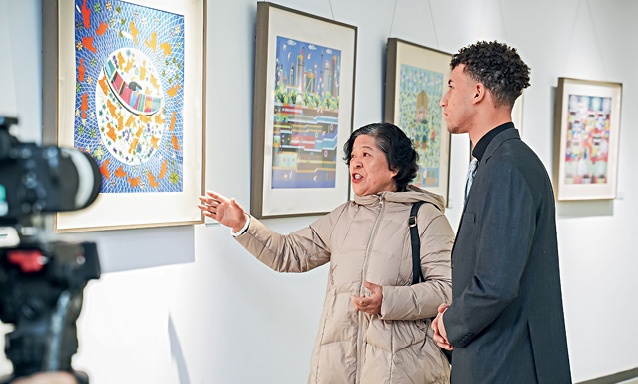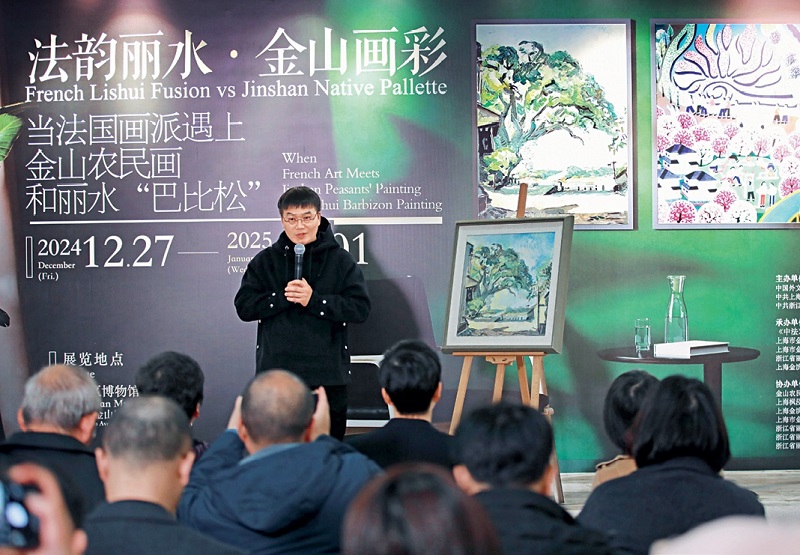
More than 100 paintings on display at the exhibition “French Lishui Fusion vs Jinshan Native Palette – When French Art Meets Jinshan Farmers’ Painting and Lishui Barbizon Painting.”
The village of Barbizon in north-cenral France, located on the outskirts of the stunning Fontainebleu Forest, became famous in art history for giving rise to a school of painting that sought realism in nature painting, based on deep observation and love for nature. Lishui is a city in Zhejiang Province in east China known as the green valley due to its extensive forest cover. Today, it has also become a channel of intercultural dialogue between China and France.
Inspired by the French Barbizon School of art, the Lishui Barbizon School was born in the 1980s. Some young local painters in Lishui integrated elements of the Barbizon School to depict their hometown, reflecting both of modern life and the natural environment of the region.
Zhejiang borders Shanghai where a district created its own style of rural people-landscape art drawn by actual rural artists. Jinshan District is the birthplace of the Jinshan farmers’ paintings and is known as the hometown of modern folk painting.
The Jinshan farmers’ paintings depict the scenery and customs of southern China, integrating folk art techniques of embroidery, paper cutting, blue calicos, murals, sculptures, and lacquer painting, using strong contrasting colors.
“Both the Jinshan farmers’ paintings and the Lishui Barbizon School are realistic. The painters show different scenery from their local area,” said Yin Jingjing, deputy director of the Jinshan Farmers’ Painting Academy.

Cao Xiuwen (left), a representative artist of Jinshan farmers’ painting, introduces one of her artworks to a foreign visitor.
In 2015, a batch of Lishui oil paintings were exhibited in Barbizon, kicking off exchanges between the Chinese and French styles of the Barbizon School. The bonds were strengthened further with Lishui’s Liandu District and Barbizon establishing sister city relations.
Recently, a new exhibition in Shanghai added to the dialogue between Eastern and Western cultures across time and space. Titled “French Lishui Fusion vs Jinshan Native Palette – When French Art Meets Jinshan Farmers’ Painting and Lishui Barbizon Painting,” the exhibition was held from December 27, 2024 to January 1, 2025. It showcased works by both Chinese and French artists, including Marie Rauzy, the great great granddaughter of Paul Cézanne, the French Post-Impressionist maestro.
“Thanks to the exhibition, more people saw the landscapes (of China and France) and their cultures,” said Lu Yongzhong, a painter of the Barbizon School from Jinshan who had lived in France for 20 years. Lu said the three styles of paintings demonstrate the painters’ deep awareness of the natural environment of their hometown and their profound understanding of real lives.
For instance, in one painting, the artist, Cao Xiuwen from Jinshan, details a woman picking herbs in a forest, drawing on her own experience.
Lei Jianhua, vice chairman of the Liandu District Federation of Literary and Art Circles, said the Lishui Barbizon School does not simply copy the original French style. “Both Barbizon schools have their own creativity to create different kinds of beauty,” he said.
“Art is rooted in the soil,” said Xia Ying, a young Jinshan farmers’ painting artist. “The French Barbizon paintings depict the scenery of France, the Lishui Barbizon paintings show the local landscape, and the Jinshan farmers’ paintings reveal the water town scenery south of the lower reaches of the Yangtze River. All three styles were born from local land.”
All three genres have a realistic basis, which creates a commonality for dialogue.

Lei Jianhua, an artist of the Barbizon School from Jinshan, delivers a speech at the opening ceremony of the exhibition. Photos by Yu Jie
An exhibition on the cultural dialogue between China and France was especially apt as the two nations celebrated the 60th year of their diplomatic relations in 2024. The exhibition highlighted the friendly exchanges between the cultural communities of both countries.
The Lishui and Jinshan paintings are also a cultural product with commercial value. “The Jinshan farmers’ paintings are sold at scenic spots, which promotes local tourism and generates income for the farmer painters,” Wu Bin, president of the Shanghai Jinbinhai Urban Development Group, said.
Jiang Shan, director of the Publicity Department of the Liandu District Committee of the Communist Party of China, said that the district has launched an artist residency initiative in recent years, with over 125 studios having moved in and about 150,000 artists visiting there every year to draw paintings from life. In addition, more than 300 institutions, such as the Central Academy of Fine Arts, have established practice bases in Liandu. The oil paintings created are exported to more than 60 countries and regions such as Europe and the United States, with their annual output value reaching RMB 120 million.
Lishui has proved time and again that art has no boundaries. French “self-taught” artist Mathieu Le Rolland’s subjects are taken from French urban life but the presentation, especially the bold, striking colors, remind viewers of the Jinshann farmers’ paintngs. He has visited Lishui multiple times to exchange ideas and create collaborative work with local artists, and his work has been exhibited in China.
He was one of the speakers on the opening day of the exhibition, saying in his video message that he looks forward to more bilateral cultural exchanges and cooperation.